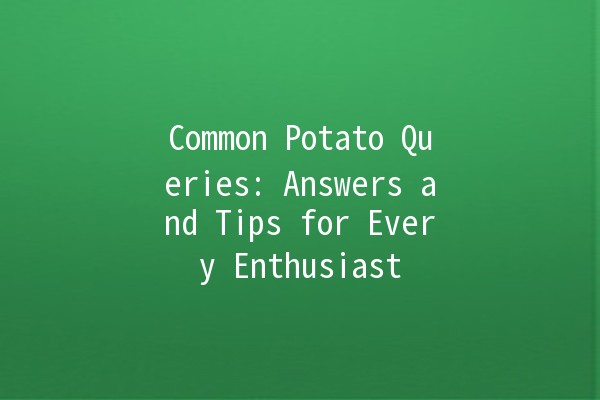Understanding Potatoes: An Overview
Potatoes are among the most versatile and beloved vegetables worldwide. They come in various shapes, sizes, and colors, and are an essential ingredient in countless dishes, ranging from mashed potatoes to french fries. However, amid their popularity, several questions frequently arise concerning their cultivation, storage, nutritional value, and culinary uses. This article addresses the most common queries about potatoes while offering valuable tips and productivity enhancements for enthusiasts, growers, and chefs alike.
Proper storage is crucial to maintaining the freshness and quality of potatoes. Here's how to do it effectively:
Keep Them Cool and Dark

Potatoes should be stored in a cool, dark place to prevent them from sprouting or turning green, which can make them toxic. Ideal storage conditions include:
Temperature: Between 45°F to 50°F (7°C to 10°C).
Location: A pantry, cellar, or garage away from direct sunlight.
Use Ventilated Containers
Ventilation is key for storing potatoes. Use burlap bags, paper bags, or boxes with ventilation holes. Avoid plastic bags, as they trap moisture and promote mold growth.
Regular Checks
Inspect your potatoes regularly and remove any that show signs of spoilage. One bad potato can lead to the faster deterioration of the rest.
Example in Application:
If you purchase a bushel of potatoes, store them in a perforated cardboard box in your basement. Check weekly for any spoilage, ensuring your potatoes last much longer.
Different cooking methods bring out different flavors and textures in potatoes. Here are some recommended techniques:
Boiling
Boiling is perfect for recipes like mashed potatoes. Cut the potatoes into uniform pieces for even cooking:
Steps: Submerge clean, peeled potatoes in salted water, bring to a boil, then lower the heat and simmer until tender.
Baking
Baked potatoes are a classic dish. Wrap them in foil for a soft texture or bake them directly on a rack for a crispy skin:
Steps: Preheat your oven to 425°F (220°C), bake for about 4560 minutes until soft.
Roasting
Roasting brings out a potato’s natural sweetness and creates a delightful crispy exterior:
Steps: Cut potatoes into chunks, toss with oil and seasoning, and roast at 400°F (200°C) for 3040 minutes.
Example in Application:
For a festive gathering, prepare a mix of roasted potatoes seasoned with herbs and garlic alongside your main dish. This allows a burst of flavor and enhances the meal experience.
Potatoes are often misunderstood regarding their nutritional value. Here’s a breakdown of their health benefits:
Nutritional Profile
Rich in Vitamins: Potatoes are an excellent source of vitamin C and B
AntiInflammatory Properties
Potatoes contain antioxidants, which can help reduce inflammation in the body.
Healthy Preparation Matters
While potatoes can be nutritious, their health benefits can be overshadowed by unhealthy cooking methods. Avoid heavy creams and excessive butter; instead, try healthier alternatives like olive oil or herbs.
Example in Application:
Incorporating boiled or baked potatoes into salads or as sides can enhance the nutritional profile of your meals without compromising flavor.
Yes, potatoes can regrow, making them an interesting plant for home gardeners. Here’s how to do it:
Choosing Seed Potatoes
Select organic potatoes with “eyes”. These are the spots where new shoots will emerge.
Planting Steps
Care Tips
Watering: Keep the soil moist but not soggy.
Light: Ensure they receive plenty of sunlight to facilitate growth.
Example in Application:
After a few months, you can harvest your potatoes and use these in your kitchen while continuing to grow fresh batches through continuous planting.
Choosing the right type of potato is crucial for meal success. Here’s a quick guide based on culinary use:
Starchy Potatoes
Best for baking or frying (e.g., Russet). They have a high starch content, resulting in a fluffy interior.
Waxy Potatoes
Ideal for salads and soups (e.g., Red or Gold potatoes). These hold their shape better during cooking.
AllPurpose Potatoes
Great for various dishes (e.g., Yukon Gold). They have a balance of waxy and starchy properties.
Example in Application:
If planning a barbecue, opt for starchy Russets to make perfect baked potatoes while choosing waxy potatoes for a potato salad.
Frequent Queries About Potatoes
Green potatoes contain solanine, which can be toxic. It’s best to discard any green parts before consuming.
Stored in a cool, dark area, potatoes can last several weeks to months, depending on the variety.
Yes, but it requires blanching them first. Freezing raw potatoes can lead to a gritty texture upon thawing.
Spoilage signs include soft spots, an off smell, and sprouting. Discard potatoes showing these signs.
Yes, potato peels are nutritious, containing fiber and various vitamins. Just be sure to wash them thoroughly to remove dirt and pesticides.
Soaking cut potatoes in cold water for a few hours before cooking can help remove excess starch.
With these insights and tips, you're now equipped to enhance your knowledge and culinary skills surrounding potatoes! Whether you're growing, cooking, or simply enjoying this versatile vegetable, there's always more to learn and explore. Remember to share your own potato recipes and experiences with friends; culinary adventures are best enjoyed together! 🍴🥔